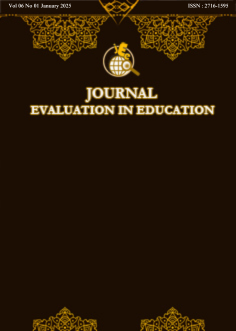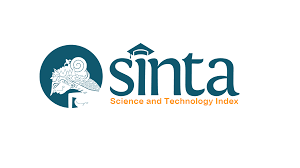Interactive H5P Framework-Based E-Learning Content in Artificial Intelligence Lectures of Indonesian Language and Literature
Abstract
Purpose of the study: This study aims to develop interactive e-learning content based on the H5P framework in Indonesian Language and Literature Artificial Intelligence lectures at the Indonesian Literature Study Program, Faculty of Languages and Arts, Universitas Negeri Medan with the formulation of the problem of how the content development takes place and how the content is feasible.
Methodology: This study uses the Research and Development method with the ADDIE model research procedure (Analysis, Design, Development, Implementation, and Evaluation).
Main Findings: E-learning based on the H5P framework in Indonesian Language and Literature Artificial Intelligence lectures is very effective. Validation by media experts showed a very good assessment (89.58% for episode 1 and 97.91% for episode 2). Validation by material experts also showed similar results (93.18% for episode 1 and 97.72% for episode 2). The interactive content developed in the form of video podcasts was able to improve student understanding and engagement through interactive quizzes and simulations.
Novelty/Originality of this study: This study develops interactive learning content based on H5P in a new context, namely the Artificial Intelligence course for Indonesian Language and Literature.
References
D. Ambarwati, U. B. Wibowo, H. Arsyiadanti, and S. Susanti, “Studi literatur: Peran inovasi pendidikan pada pembelajaran berbasis teknologi digital [Literature study: The role of educational innovation in digital technology-based learning],” J. Inov. Teknol. Pendidik., vol. 8, no. 2, pp. 173–184, 2021.
L. Hadisi and W. Muna, “Pengelolaan teknologi informasi dalam menciptakan model inovasi pembelajaran (e-learning) [Management of information technology in creating learning innovation models (e-learning)],” Al-Ta’dib, vol. 8, no. 1, pp. 117–140, 2015.
M. I. Khalil, M. Humayun, and N. Z. Jhanjhi, “COVID-19 impact on educational system globally,” 2021, pp. 257–269. doi: 10.1007/978-3-030-60039-6_13.
I. G. I. Sudipa et al., Penerapan Sistem Informasi di Berbagai Bidang [Application of Information Systems in Various Fields]. PT. Sonpedia Publishing Indonesia, 2023.
K. Utami, M. Akhyar, and S. Sudiyanto, “Potential implementation of android-based interactive multimedia for student learning activities,” AL-ISHLAH J. Pendidik., vol. 15, no. 1, pp. 507–518, 2023, doi: 10.35445/alishlah.v15i1.2641.
F. Almagofi, H. Sya’diyah, R. Gultom, and D. M. Sukmawati, Media interaktif dalam pembelajaran IPS sd [Interactive media in elementary school social studies learning], Cahya Ghani Recovery, 2023.
D. Aziz, “Metode belajar interaktif berbasis multimedia: Telaah pembelajaran ilmu fiqh di madrasah aliyah laboratorium di Kota Jambi [Interactive learning methods based on multimedia: A study of Islamic jurisprudence learning at laboratory Islamic high schools in Jambi City],” Innov. J. Relig. Innov. Stud., vol. 17, no. 2, pp. 207–219, 2017.
H. D. Surjono, Multimedia Pembelajaran Interaktif konsep dan pengembangan [Multimedia Interactive Learning concept and development], Yogyakarta: UNY Press, 2017.
S. Domagk, R. N. Schwartz, and J. L. Plass, “Interactivity in multimedia learning: An integrated model,” Comput. Human Behav., vol. 26, no. 5, pp. 1024–1033, 2010, doi: 10.1016/j.chb.2010.03.003.
R. Andari, “Pemanfaatan media pembelajaran berbasis game edukasi kahoot! pada pembelajaran fisika [Utilization of educational game-based learning media Kahoot! in physics learning],” ORBITA J. Kajian, Inov. Dan Apl. Pendidik. Fis., vol. 6, no. 1, pp. 135–137, 2020.
S. B. Dias, J. A. Diniz, and L. J. Hadjileontiadis, Towards an Intelligent Learning Management System Under Blended Learning, vol. 59. in Intelligent Systems Reference Library, vol. 59. Cham: Springer International Publishing, 2014. doi: 10.1007/978-3-319-02078-5.
A. David, D. Mihai, M.-E. Mihailescu, M. Carabas, and N. Tapus, “Scalability through distributed deployment for moodle learning management system,” Procedia Comput. Sci., vol. 214, pp. 34–41, 2022, doi: 10.1016/j.procs.2022.11.145.
Y. Benkler, “Peer production and cooperation,” in Handbook on the Economics of the Internet, Edward Elgar Publishing, 2016. doi: 10.4337/9780857939852.00012.
A. Sultoni, Riswandi, Muallimin, and F. Yeni J, “Pengembangan Media Pembelajaran Qawā‘id Berbasis Aplikasi H5P untuk Meningkatkan Antusiasme Belajar Siswa MTsN 1 Pringsewu [Development of Qawā‘id learning media based on H5P applications to increase student enthusiasm for learning at MTsN 1 Pringsewu],” al Mahāra J. Pendidik. Bhs. Arab, vol. 7, no. 2, pp. 285–300, 2021, doi: 10.14421/almahara.2021.072-07.
A. Jaedun, M. Nurtanto, F. Mutohhari, I. N. Saputro, and N. Kholifah, “Perceptions of vocational school students and teachers on the development of interpersonal skills towards Industry 5.0,” Cogent Educ., vol. 11, no. 1, 2024, doi: 10.1080/2331186X.2024.2375184.
S. Supa’at and I. Ihsan, “The challenges of elementary education in society 5.0 Era,” Int. J. Soc. Learn., vol. 3, no. 3, pp. 341–360, 2023, doi: 10.47134/ijsl.v3i3.214.
M. Poláková, J. H. Suleimanová, P. Madzík, L. Copuš, I. Molnárová, and J. Polednová, “Soft skills and their importance in the labour market under the conditions of Industry 5.0,” Heliyon, vol. 9, no. 8, p. e18670, 2023, doi: 10.1016/j.heliyon.2023.e18670.
M. K. Budiarto, Asrowi, Gunarhadi, R. Karsidi, and A. Rahman, “E-Learning platform for enhancing 21st century skills for vocational school students: A systematic literature review,” Electron. J. e-Learning, vol. 22, no. 5, pp. 76–90, Jun. 2024, doi: 10.34190/ejel.22.5.3417.
A. G. Siregar and F. Sembiring, “Interactive learning content using H5P in pronunciation course,” J. Educ. Hum. Soc. Sci., vol. 5, no. 2, pp. 1219–1225, 2022, doi: 10.34007/jehss.v5i2.1474.
D. A. Utari, M. Miftachudin, L. E. Puspandari, I. Erawati, and D. Cahyaningati, “Pemanfaatan H5P dalam pengembangan media pembelajaran bahasa online interaktif [Utilization of H5P in developing interactive online language learning media],” J. Pendidik. Bhs. dan Sastra Indones. Met., vol. 7, no. 1, pp. 63–69, 2022, doi: 10.21107/metalingua.v7i1.14896.
H. Khosravi et al., “Explainable Artificial Intelligence in education,” Comput. Educ. Artif. Intell., vol. 3, p. 100074, 2022, doi: 10.1016/j.caeai.2022.100074.
S. Nikolic et al., “ChatGPT versus engineering education assessment: a multidisciplinary and multi-institutional benchmarking and analysis of this generative artificial intelligence tool to investigate assessment integrity,” Eur. J. Eng. Educ., vol. 48, no. 4, pp. 559–614, 2023, doi: 10.1080/03043797.2023.2213169.
T. Jacob and S. Centofanti, “Effectiveness of H5P in improving student learning outcomes in an online tertiary education setting,” J. Comput. High. Educ., vol. 36, no. 2, pp. 469–485, 2024, doi: 10.1007/s12528-023-09361-6.
A. Kumar et al., “Blended learning tools and practices: A comprehensive analysis,” IEEE Access, vol. 9, pp. 85151–85197, 2021, doi: 10.1109/ACCESS.2021.3085844.
D. D. Prasetya, A. P. Wibawa, T. Hirashima, and Y. Hayashi, “Designing rich interactive content for blended learning: A case study from Indonesia,” Electron. J. e-Learning, vol. 18, no. 4, 2020, doi: 10.34190/EJEL.20.18.4.001.
N. Megahed and A. Hassan, “A blended learning strategy: Reimagining the post-Covid-19 architectural education,” Archnet-IJAR Int. J. Archit. Res., vol. 16, no. 1, pp. 184–202, 2022, doi: 10.1108/ARCH-04-2021-0081.
D. Fatimatuzzahro and M. N. Ahsin, “Peran bahasa dan sastra indonesia dalam pembuatan cerpen di era 5.0 [The role of Indonesian language and literature in creating short stories in the 5.0 era],” in Seminar Nasional Peran Bahasa dan Sastra Indonesia dalam Industri Kreatif Era 5.0, pp. 78–82, 2022.
E. S. W. Taruklimbong and H. Sihotang, “Peluang dan tantangan penggunaan AI (Artificial Intelligence) dalam pembelajaran kimia [Opportunities and challenges of using AI (Artificial Intelligence) in chemistry learning],” J. Pendidik. Tambusai, vol. 7, no. 3, pp. 26745–26757, 2023.
K. Tammets and T. Ley, “Integrating AI tools in teacher professional learning: a conceptual model and illustrative case,” Front. Artif. Intell., vol. 6, 2023, doi: 10.3389/frai.2023.1255089.
C. ’Ilaiu Talei, M. Mosavat, B. Martin, J. Androutsou, H. Kim, and T. Chung, “Lessons learned during the design implementation of a digital construction site module,” ASCILITE Publ., pp. 404–408, 2024, doi: 10.14742/apubs.2024.1146.
M. C. Sáiz-Manzanares, R. Marticorena-Sánchez, M. C. Escolar-Llamazares, I. González-Díez, and R. Velasco-Saiz, “Using serious game techniques with health sciences and biomedical engineering students: an analysis using machine learning techniques,” Information, vol. 15, no. 12, p. 804, 2024, doi: 10.3390/info15120804.
R. Suratnu, “The adoption of the addie model in designing an instructional module: The case of malay language remove students,” IJIET (International J. Indones. Educ. Teaching), vol. 7, no. 2, pp. 262–270, 2023, doi: 10.24071/ijiet.v7i2.3521.
Z. Ozdilek and E. Robeck, “Operational priorities of instructional designers analyzed within the steps of the Addie instructional design model,” Procedia - Soc. Behav. Sci., vol. 1, no. 1, pp. 2046–2050, 2009, doi: 10.1016/j.sbspro.2009.01.359.
A. G. Spatioti, I. Kazanidis, and J. Pange, “A comparative study of the ADDIE instructional design model in distance education,” Information, vol. 13, no. 9, p. 402, 2022, doi: 10.3390/info13090402.
R. Rabiman, F. Oksandi, and A. Khaharsyah, “Learning technology using flipping book in vocational education: ADDIE model,” 2024, p. 030017. doi: 10.1063/5.0214392.
S. J. Derry et al., “Conducting video research in the learning sciences: Guidance on Selection, Analysis, Technology, and Ethics,” J. Learn. Sci., vol. 19, no. 1, pp. 3–53, 2010, doi: 10.1080/10508400903452884.
S. Rosdiana, M. A. Noercolies, and M. H. Fauzan, “The use of artificial intelligence in teaching writing skills,” Educ. J. Pendidikan, Pengajaran, dan Pembelajaran, vol. 9, no. 1, pp. 45–56, 2024, doi: 10.21462/educasia.v9i1.251.
N. V Shumeiko and K. P. Osadcha, “Application of artificial intelligence in higher education institutions for developing soft skills of future specialists in the sphere of information technology,” J. Phys. Conf. Ser., vol. 2871, no. 1, p. 012027, 2024, doi: 10.1088/1742-6596/2871/1/012027.
P. K. Atrey, M. A. Hossain, A. El Saddik, and M. S. Kankanhalli, “Multimodal fusion for multimedia analysis: a survey,” Multimed. Syst., vol. 16, no. 6, pp. 345–379, 2010, doi: 10.1007/s00530-010-0182-0.
P. Goldstraw et al., “The IASLC lung cancer staging project: Proposals for the revision of the TNM stage groupings in the forthcoming (Seventh) edition of the TNM classification of malignant tumours,” J. Thorac. Oncol., vol. 2, no. 8, pp. 706–714, 2007, doi: 10.1097/JTO.0b013e31812f3c1a.
Copyright (c) 2025 Muhammad Anggie Januarsyah Daulay, Achmad Yuhdi, Adek Cerah Kurnia Azis

This work is licensed under a Creative Commons Attribution 4.0 International License.
Authors who publish with this journal agree to the following terms:
- Authors retain copyright and acknowledge that the Integrated Science Education Journal is the first publisher licensed under a Creative Commons Attribution 4.0 International License.
- Authors are able to enter into separate, additional contractual arrangements for the non-exclusive distribution of the journal's published version of the work (e.g., post it to an institutional repository or publish it in a book), with an acknowledgment of its initial publication in this journal.
- Authors are permitted and encouraged to post their work online (e.g., in institutional repositories or on their website) prior to and during the submission process, as it can lead to productive exchanges and earlier and greater citation of published work.









.png)
.png)




